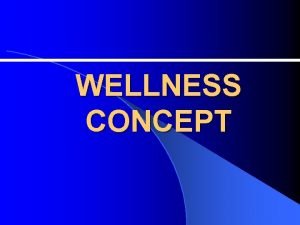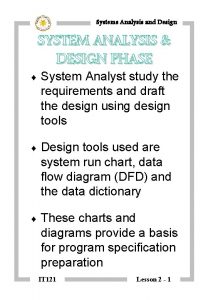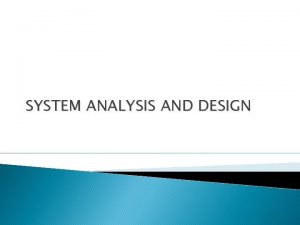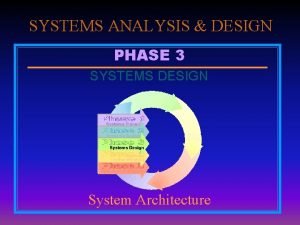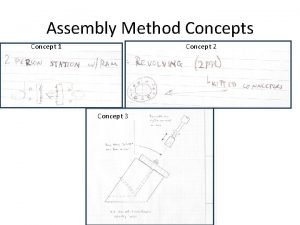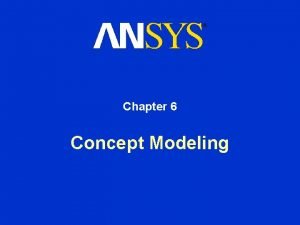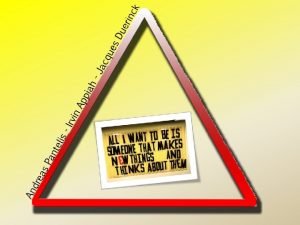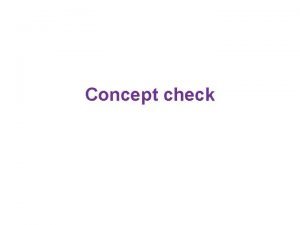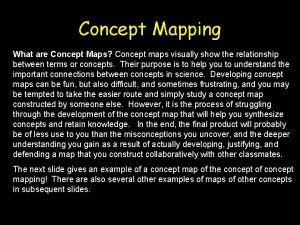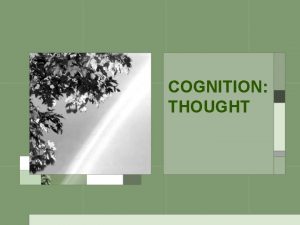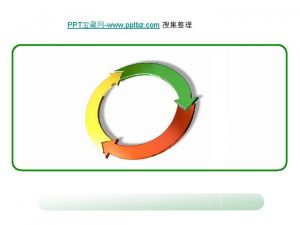System Concept System Analysis Design Systems analysis and













- Slides: 13

System Concept

System Analysis & Design � Systems analysis and design is a systematic approach to identify ◦ problem ◦ opportunities ◦ objectives analyzing the information flows in organizations; and designing computerized information systems to solve a problem

System Concept �A System is a set of components that interact with one another and serve for a common purpose or goal. � Basically there are three major components in every system, namely input, processing and output

Types of System � Abstract System: is conceptual, a product of a human mind. That is, it cannot be seen or pointed to as an existing entity. Social, cultural systems are abstract systems. None of them can be photographed, drawn or otherwise physically pictured. However, they do exist and can be discussed, studied analyzed. � Physical System: in contrast, has a material nature. It is based on material basis rather than on ideas or theoretical notions.

Types of System Cont… � Open or Closed System: An open system has many interfaces with its environment. It permits interaction across its boundary; it receives inputs from and delivers outputs to the outside.

System Characteristics 1. 2. 3. 4. 5. 6. 7. 8. 9. Components Interrelationships Boundary Purpose Environment Input Output Interface Constraints

System Characteristics Cont… � � � A Component is either an irreducible part or an aggregate of parts, also called a subsystem. The simple concept of a component is very powerful. For example, in case of an automobile we can repair or upgrade the system by changing individual components without having to make changes the entire system. The components are Interrelated; that is, the function of one is somehow tied to the function of the others. For example, in the Store system the work of one component, such as producing a daily report of customer orders, may not progress successfully until the work of another component is finished, such as sorting customer orders by date of receipt. A system has a Boundary, within which all of its components are contained and which establishes the limits of a system, separating it from other systems.

System Characteristics Cont… � All of the components work together to achieve some overall Purpose: the system’s reason for existing. �A system operates within an Environment – everything outside the system’s boundary. The environment surrounds the system, both affecting it and being affected by it. For example, the environment of a university includes prospective students, foundations, funding agencies and the new media. Usually the system interacts with its environment. A university interacts with prospective students by having open houses and recruiting from local high schools. � The point at which the system meets its environment are called Interface.

System Characteristics Cont… � � A system must face Constraints in its functioning because there are limits to what it can do and how it can achieve its purpose within its environment. Some of these constraints are imposed inside the system (e. g. , a limited number of staff available). Others are imposed by the environment (e. g. , due to regulations). A system interact with the environment by means of Input & Output. Input is anything entering the system from the environment; Output is anything leaving the system crossing the boundary to the environment. Information, energy, and material can be both input and output in relation to the environment. People, for example, take in food, oxygen, and water from the environment as input. An electrical utility takes on input from the environment in the form of raw materials (coal, oil, water power, etc), requests for electricity from customers. It provides for output to the environment in the form of electricity.

System Control & Feedback � Very often output’s data are returned to the input of the system, as shown in Fig. 1 -2, and used to regulate the system’s activity. Large hotels and motels, for instance, ask guests to fill out cards evaluating the services. Such a process is called feedback. It helps to adjust the system to changes so that the system operates in a balanced state, or equilibrium. This feature of a system is used in control. � Control is the process that measures current performance and guides it toward a predetermined goal.

SYSTEM processing boundary controls inputs feedback outputs

System Control & Feedback Cont… � Two types of feedback are related to system control. ◦ Negative feedback is corrective feedback that helps maintain the system within a critical operating range and reduces performance fluctuations around the norm or standard. Negative feedback is transmitted in feedback control loops. As shown in Figure 1 -3, a sensor detects the effect of output on the external environment; this information is returned to the system as an input, and necessary adjustments are made according to predetermined goal.

System Control & Feedback Cont… � In contrast to negative feedback, which is corrective, positive feedback reinforces the operation of a system by causing it to continue its performance and activities without changes.
 Output design in system analysis and design
Output design in system analysis and design When to use sdlc
When to use sdlc User interface design in system analysis and design
User interface design in system analysis and design Dialogue design
Dialogue design Systems analysis & design in an age of options pdf
Systems analysis & design in an age of options pdf Gantt chart system analysis and design
Gantt chart system analysis and design Systems analysis and design in a changing world
Systems analysis and design in a changing world System analysis and design in a changing world
System analysis and design in a changing world Alan dennis system analysis design
Alan dennis system analysis design Introduction of system analysis and design
Introduction of system analysis and design Structured system analysis and design method
Structured system analysis and design method Case tools are limited to systems analysis.
Case tools are limited to systems analysis. Modern systems analysis and design
Modern systems analysis and design Kendall and kendall system analysis and design
Kendall and kendall system analysis and design














